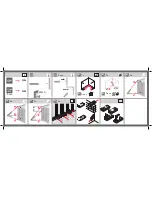
●
Dell Command | Deploy
—Enables easy operating system deployment across all major Operating System (OS) deployment
methodologies and provides numerous system-specific drivers that have been extracted and reduced to an Operating
System-consumable state.
●
Dell Command l Configure
—A graphical user interface (GUI) admin tool for configuring and deploying hardware settings in
a pre-Operating System or post-Operating System environment. It operates seamlessly with SCCM and Airwatch and can be
self-integrated into LANDesk and KACE. Command l Configure allows you to remotely automate and configure over 150+
BIOS settings for a personalized user experience.
●
Dell Command l PowerShell Provider
—Can do the same things as Command l Configure, but with a different method.
PowerShell is a scripting language that allows customers to create a customized and dynamic configuration process.
●
Dell Command l Monitor
—A Windows Management Instrumentation (WMI) agent that provides IT administrators with an
extensive inventory of the hardware and health-state data. IT administrators can also configure hardware remotely by using
command line and scripting.
●
Dell Command | Update (end-user tool)
—A factory-installed software and allows IT administrators to individually manage
and automatically present, install Dell updates to the BIOS drivers, and software. Command Update eliminates the time-
consuming process of update installation.
●
Dell Command l Update Catalog
—Provides searchable metadata that allows the management console to retrieve the
latest system-specific updates (driver, firmware, BIOS). The updates are then delivered seamlessly to end-users using the
customer’s systems management infrastructure that is consuming the catalog (like SCCM).
●
Dell Command | vPro Out of Band console
—Extends hardware management to systems that are offline or have an un-
reachable Operating System (Dell exclusive features).
●
Dell Command | Integration Suite for System Center
—Integrates all the key components of the Client Command Suite
into Microsoft System Center Configuration Manager 2012 and Current Branch versions.
USB features
Universal Serial Bus, or USB, was introduced in 1996. It dramatically simplified the connection between host computers and
peripheral devices like mice, keyboards, external drivers, and printers.
Table 6. USB evolution
Type
Data Transfer Rate
Category
Introduction Year
USB 1.x
12 Mbps
Full Speed
1996
USB 2.0
480 Mbps
High Speed
2000
USB 3.0
5 Gbps
SuperSpeed
2010
USB 3.1
10 Gbps
Sup
2010
USB 3.2
20 Gbps
Sup
2017
USB4
40 Gbps
Sup and
Thunderbolt 3
2019
USB 3.2 Gen 1 (SuperSpeed USB)
For years, the USB 2.0 has been firmly entrenched as the de facto interface standard in the PC world with about 6 billion
devices sold, and yet the need for more speed grows by ever faster computing hardware and ever greater bandwidth demands.
The USB 3.2 Gen 1 finally has the answer to the consumers' demands with a theoretically 10 times faster than its predecessor. In
a nutshell, USB 3.2 Gen 1 features are as follows:
●
Higher transfer rates (up to 5 Gbps)
●
Increased maximum bus power and increased device current draw to better accommodate power-hungry devices
●
New power management features
●
Full-duplex data transfers and support for new transfer types
●
Backward USB 2.0 compatibility
●
New connectors and cable
14
Technology and components
Summary of Contents for D16S
Page 17: ...3 Major components of your system 17 ...
Page 18: ...Major components of your system 18 Major components of your system ...
Page 48: ...48 Disassembly and reassembly ...
Page 68: ...68 Disassembly and reassembly ...
Page 70: ...70 Disassembly and reassembly ...
Page 75: ...Disassembly and reassembly 75 ...
Page 77: ...Disassembly and reassembly 77 ...















































